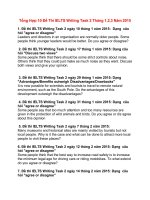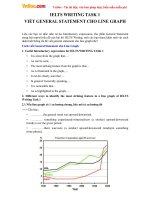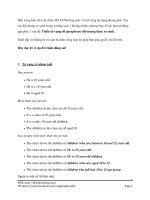Some IELTS writing (task 1 and task 2)
Bạn đang xem bản rút gọn của tài liệu. Xem và tải ngay bản đầy đủ của tài liệu tại đây (239.7 KB, 12 trang )
Writing task 1
1) The leading (source) of…….in the world is (from)/has come from…….(…%)
2) ….. is the leading…./ is the top….. of………. (%)
3) ….. is the main source of…….in the world (%)
4) …… is the primary region/country/ primary/top country of origin for …….
(migrants) in the world (%)
5) …….. make up the second-largest/ largest share of ….. in the world
(people who have migrants across borders - almost 60M)
-> (%)…..(hindu) (about …M) account for (%)
6) the largest/ second-largest share of……. In the world has come from ……
(số liệu)
7) ….. has the largest/biggest share of…..(from other religions) in the world
(-)
8) …… ranks as the largest/biggest country of…….in the world (-)
9) …… has been the main source of ……(…M) emigrants
𝐂𝐎𝐍𝐓𝐑𝐈𝐁𝐔𝐓𝐄
Ví dụ: The iPhone 𝑎𝑐𝑐𝑜𝑢𝑛𝑡𝑒𝑑 𝑓𝑜𝑟 approximately 60% of Apple's revenue
over the last four quarters.
The iPhone 𝒄𝒐𝒏𝒕𝒓𝒊𝒃𝒖𝒕𝒆𝒅 approximately 60% of Apple's revenue over the
last four quarters.
𝐌𝐀𝐊𝐄 𝐔𝐏
Ví dụ: The company's Services segment 𝑎𝑐𝑐𝑜𝑢𝑛𝑡𝑒𝑑 𝑓𝑜𝑟 about 18% of the
total income in 2019.
The company's Services segment 𝒎𝒂𝒅𝒆 𝒖𝒑 about 18% of the total income
in 2019.
𝐂𝐎𝐌𝐏𝐑𝐈𝐒𝐄
Ví dụ: Agriculture, which ℎ𝑎𝑑 less than a quarter of Turkey's economy in
2000, fell to 14% in 2016.
Agriculture, which 𝒄𝒐𝒎𝒑𝒓𝒊𝒔𝒆𝒅 less than a quarter of Turkey's economy in
2000, fell to 14% in 2016.
- khu vực châu á – thái bình dương: asia-pacific
- người theo đạo thiên chúa: christians
- người theo đạo hindu: hindus
- người theo đạo hồi: muslims
- người theo đạo chúa: buddhists
- người do thái: jewish (migrants)
- người không theo đạo: unaffiliated/ non religious migrants
- các tín đồ theo đạo: adherents of all other faiths
- người theo các đạo khác: other religions/ other religious migrants
1) (%) of ….. went to museums and----- in 1999
2) more than (số liệu) of …… (%) had been to galleries------in 1999
3) there was (số liệu) of…...who had been to ………..
4) ……….. had welcomed (%) of……
5) museums were visited by (%) of the sample
6)
- người được khảo sát: surveyed visitors = (the) people surveyed =
respondent = the sample
Các từ chia tỉ lệ thông dụng:
10% - one in ten
25% - a quarter
20% - a fifth
30% - nearly a third
33% - a third
51% - more than a half
75% - three quarters
97% - a majority
Đối với dạng bài tỉ lệ, phần trăm, việc sử dụng đa dạng từ vựng thay vì lặp đi
lặp lại về số liệu sẽ giúp bài viết của bạn được đánh giá cao hơn. Bạn có thể
tham khảo cách viết như bảng dưới:
5% - a small fraction
10% - a tenth, one in ten
15% - less than a fifth
20% - a fifth
25% - a quarter
30% - nearly a third
33% - a third, one-third
50% - a half
65% - nearly two-thirds
75% - three
quarters
Trong trường hợp tỉ lệ phần trăm là số lẻ, các bạn có thể sử dụng các từ như
Nearly, Almost, Around (Gần như) hay Over, More than (Quá) để miêu tả.
Ví dụ:
• 32% - Nearly a third
• 49% - Almost a half
• 68% - Over two-thirds
9% A small fraction
35% Just over/More than a third
76% More than/Over three quarters
Để miêu tả các số liệu liên quan đến phần trăm và tỉ lệ, các bạn có thể sử
dụng các động từ như:
account for = make up = consist of = comprise + ... %
Ví dụ: The number of 1st grade students accounts for 15% of the total
students at Thang Long Primary School.
Một số ví dụ về cách dùng từ vựng tả tỉ lệ phần trăm, theo dạng số,
chữ, kí hiệu.
Percentages: a 10% increase, a 25 percent decrease,, increased by 15%,
dropped by 10 per cent, fall at 50%, reached to 75%, tripled, doubled, onefourth, three-quarters, half, double fold, treble, 5 times higher, 3 timers
lower, declined to about 49%, stood exactly at 43%.
Fractions:
4% = A tiny fraction.
24% = Almost a quarter.
25% Exactly a quarter.
26% = Roughly one quarter.
32% Nearly one-third, nearly a third.
49% = Around a half, just under a half.
50% = Exactly a half.
51% = Just over a half.
73% = Nearly three quarters.
77% = Approximately three quarter, more than three-quarter.
79% = Well over three quarters.
Proportions:
2% = A tiny portion, a very small proportion.
4% = An insignificant minority, an insignificant proportion.
16% = A small minority, a small portion.
70% = A large proportion.
72% = A significant majority, A significant proportion.89% = A very large
proportion.
89% = A very large proportion.
- Sample:
Task 1: The chart and table below show customer satisfaction levels
in the US with airlines and aspects of air travel in 1999, 2000, and
2007.
Summarize the information by selecting and reporting the main
features and making comparisons where relevant.
- introduction:
1) gộp chung: the 2 chart illustrate the information about
2) tách ra riêng 2 chart
-> The chart and table illustrate the proportion of different extents of client
contentment regarding four aspects of air service in the US from 1999 to
2007.
- overview: xu hướng (trend)
+ Overall, over a given period of time, the number of people who are
satisfied with the service increased steadily, while the percentage of the
opposition showed a downward trend.
- body 1: phân tích chart
+ The year between 1999 and 2007 witnessed a positive movement in the
satisfaction scales of consumers. There was moderate growth of 4% in the
percentage of guests pleased with the airline agency from 1999 to 2000.
Finally, it reached the highest point of 72% in 2007. On the other hand, the
unsatisfied category had a minor decline, falling from 32% to 24%, a drop of
8% in 8 years.
- body 2: phân tích table
+ According to the table, the proportion of customers satisfied with flight
attendant courtesy increased by 4% between 1999 and 2007, peaking at 92
percent. In the same period, the price of tickets had a dramatic increase
from 45% to 65% between 1999 and 2007. In 1999, 75% of visitors were
comfortable with their schedules; after one year, this figure increased to
79%, and then remained stable for the next seven years. Only 47% of
travelers felt the seats were pleasant, but this figure did not exist in 1999 or
2000.
Essay:
The chart and table illustrate the proportion of different extents of client
contentment regarding four aspects of air service in the US from 1999 to
2007.
Overall, over a given period of time, the number of people who are satisfied
with the service increased steadily, while the percentage of the opposition
showed a downward trend.
The year between 1999 and 2007 witnessed a positive movement in the
satisfaction scales of consumers. There was moderate growth of 4% in the
percentage of guests pleased with the airline agency from 1999 to 2000.
Finally, it reached the highest point of 72% in 2007. On the other hand, the
unsatisfied category had a minor decline, falling from 32% to 24%, a drop of
8% in 8 years.
According to the table, the proportion of customers satisfied with flight
attendant courtesy increased by 4% between 1999 and 2007, peaking at 92
percent. In the same period, the price of tickets had a dramatic increase
from 45% to 65% between 1999 and 2007. In 1999, 75% of visitors were
comfortable with their schedules; after one year, this figure increased to
79%, and then remained stable for the next seven years. Only 47% of
travelers felt the seats were pleasant, but this figure did not exist in 1999 or
2000.
Writing task 2
Write about the topic:
Many children these days have an unhealthy lifestyle. Both school
and parents are responsible for solving this problem. To what extent
do you agree with this statement?
Give reasons for your answer and include relevant examples from
your own knowledge or experience.
1. Is it true that many children have an unhealthy lifestyle? Why?
- Yes, it is. Because of the excessive social networking, children lose
gradually the act of community skills and also follow to bad habits on the
Internet so that children have a sendentary lifestyle as an unhealthy lifestyle
2. Are parents responsible? Why? What should they do?
- Yes, they are. Because parents are the closest people to the children. They
should take care of their children, which is their obligation and responsibility
of parents to provide their children with proper guideline.
3. Are schools responsible? Why? What should they do?
- Yes, they are. Schools should educate children to remove bad habits and
built up a new positive lifestyle for students.
4. Is anyone else responsible? Who?
- I think that friends will also be responsible for solving the problems.
Because they can give advice to their classmate to have an active style of
living.
Essay:
There is no doubt that things have changed over the past few years,
humankind has seen various issues about the style of living among the
teenagers. Children’s life now is quite different from they used to be in the
past and they tend to have negative effect on their living. This essay will
analyze why parents and schools should be responsible for solving this
problem.
To begin with, it is worth considering that at school, some students are not
acutely aware of the significance of adopting a vigorous lifestyle, since
children spend most of the time studying in institute consequently
youngsters might be affected by negative lifestyle of the other person.From
my perspective, administrators should give healthy snacks and lunches to
the youngsters with cutting off the junk food from the canteen. Besides,
teacher should educate adolescents about the importance of well lifestyle
and consequences of bad customs on their health. This measure serves as a
remedy for making right nature choices.
On the other hand, family has crucial part in teaching children to avoid
health-deteriorating habits by setting a good exemplary for them to follow.
For instance, they may take part in physical activities on a regular basis,
which not only build a good routine but also help children to keep fit. Parents
should have the initiative to train their children to consume healthy food or a
balance diet, which can provide nutrition for a healthy body. Furthermore,
they can also teach them what are the sources of reaching low calories and
giving live examples of the worst effect of fast cuisine.
In conclusion, taking everything into consideration, it is advisable for
teenagers to be aware of the importance of good behavior. Hence, parents
and academies exert a massive impact on teaching boys and girls how to
live healthily.
To learn effectively, children need to eat a healthy meal at schools.
How true is this statement? Whose responsibility to provide food for
school children?
*Learn effectively = focus on studying, gain proficiency, acquire knowledge,
improve study skills, have the capability to learn,…
*Healthy meal = nutritious food/meal, healthy dish, balanced
diet/dinner/breakfast/lunch/meal, healthy food, nourishing meals,…
*Responsibility to = take care of, pay attention to, play a role in, the obligation to,
have a duty to,…
* Provide = supply, require, afford, maintain,…
- Introduction:
+ To gain proficiency in studying -> children must have a nutritious meal to require
healthy for a whole day of learning.
+ It seems to me that schools and parents both play a crucial part in supplying and
taking care of students’ balanced meals.
- Body 1: support
+ In terms of mental well-being ->nutrition plays an important part of our life-> eat
more nutritious food such as fruits, vegetables, low-calorie food, and protein food,…
(which contain lots of vitamins and minerals) -> following a healthy pattern of eating
is linked with better stress management, improved sleep quality, increased
concentration, and better mental wellbeing in general -> enable students to
concentrate on studying and stabilize a child’s mood sharpen their minds/ be able to
memorize lectures from lectures or information from teachers -> for ex: eating
healthy food can help to prevent bipolar disorder
- Body 2: against
+ However, nowadays, most of the youngsters have harmful dishes or skip meals,
which tend to become a huge negative -> many children may opt for skipping
breakfast or eating adequate nutrients for a day -> some students may prefer
eating fast-food, takeaway food, sth unhealthy food for a quick snack or not having
enough time to eat (consume excessive fast food due to lack of time to prepare for
the meal) -> lead to health – deteriorating
- Body 3: responsibility
+ Schools-> school administrators must form the habit of eating healthy food -> not
only facilities and education but also a good meal -> provide meals for students.
+ Parents: parents must choose food for their children which are suitable for
themselves and their preference -> moreover, it is necessary for parents to have
healthy nutrition for kids in association with classifying the impact of that on the
children's lives.
Example: United States Department of Agriculture requires the national school lunch
and breakfast program with healthy and nutritious meals to millions of American
children every day.
ESSAY
Children must have a balanced lunch before learning in order to maintain
their strength throughout the day. As a matter of fact, it seems to me that
both parents and schools have a critical role to play in providing and caring
for the balanced meals that students need.
Nutrition is a crucial aspect of our lives and plays a significant role in terms of
emotions and mental health. Students could lower stress, improve focus, and
develop mental health by eating more nutrient-dense foods including fruits,
vegetables, low-calorie foods, and protein-rich foods that are high in vitamins and
minerals. Therefore, it fosters toddle to have an interest in studying and stabilizing a
child’s moods and sharpening their minds. For example, consuming nutritious food
can help to prevent bipolar disorder and ADHD in certain situations.
On the other hand, nowadays, most youngsters have a tendency to have harmful
diets, which may lead to health-damaging habits. Some kids may choose to skip
meals or consume inadequate nutrition for the day. As a result, they may prefer
eating fast-food or takeaway food due to the lack of time to prepare the meal. In
fact, this will lead to health – deterioration.
In my opinion, parents and schools both have a significant part in encouraging
children to follow healthy habits. In order to provide meals for kids, school
administrators must first develop the habit of eating a nutritious diet. Schools can
not only give facilities and instruction, but also a good meal. Second, parents should
select food for their children based on their own preferences and suitability.
Additionally, it is important for parents to provide a balanced diet for their children
while also classifying the impacts it would have on their lifestyles.
In conclusion, a balanced meal will enable kids to learn more effectively.
Furthermore, it is the duty of both parents and schools to train their children to
consume nourishing meals.






